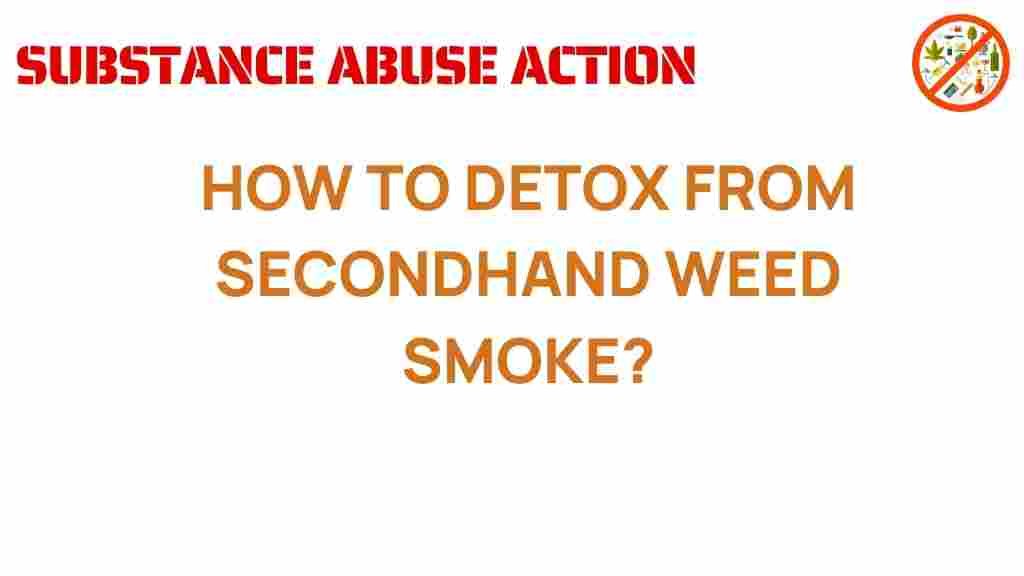Detox from Secondhand Weed Smoke: Understanding the Process
As cannabis becomes increasingly legalized and socially accepted, more individuals are finding themselves exposed to secondhand weed smoke. While many people use marijuana for its therapeutic benefits, the health effects of cannabis exposure, particularly through secondhand smoke, remain a topic of concern. In this article, we will unravel the mystery of detoxing from secondhand weed smoke, exploring its health impacts, recovery processes, and how to manage exposure in various social settings.
Understanding Secondhand Weed Smoke
Secondhand weed smoke refers to the inhalation of smoke that comes from burning cannabis, whether it’s from joints, blunts, or vaporizers. Similar to tobacco smoke, secondhand cannabis smoke contains a mix of harmful chemicals and particulate matter, which can have adverse effects on respiratory health.
Key components of secondhand weed smoke include:
- THC (tetrahydrocannabinol)
- Other cannabinoids
- Tar
- Carcinogens
- Carbon monoxide
Understanding these components is crucial for recognizing the potential health risks associated with secondhand cannabis exposure.
Health Effects of Secondhand Cannabis Exposure
The health effects of secondhand smoke can vary depending on the level and duration of exposure. Some potential health issues include:
- Respiratory Problems: Irritation of the lungs and airways can lead to coughing, wheezing, and other respiratory issues.
- Cardiovascular Effects: Secondhand smoke can affect heart health, potentially leading to increased heart rate and blood pressure.
- Impaired Cognitive Function: Exposure may affect attention and memory, especially in children and adolescents.
- Long-term Risks: Prolonged exposure can increase the risk of chronic bronchitis and other serious health conditions.
Given these potential health effects, it’s important to understand how to detox from secondhand weed smoke effectively.
Step-by-Step Process to Detox from Secondhand Smoke
Detoxing from secondhand weed smoke involves various strategies to cleanse your system and improve respiratory health. Here’s a step-by-step guide:
1. Identify Exposure Sources
Begin by identifying where and when you are exposed to secondhand weed smoke. Common scenarios include:
- At parties or social gatherings
- In shared living environments
- Public spaces where smoking is prevalent
By recognizing these sources, you can take proactive measures to limit your exposure.
2. Improve Indoor Air Quality
Indoor air quality significantly affects your overall health. Here are some tips to enhance it:
- Ventilation: Ensure proper ventilation in your living space. Open windows and use exhaust fans to circulate fresh air.
- Air Purifiers: Invest in high-quality air purifiers equipped with HEPA filters to remove smoke particles.
- Houseplants: Some plants can naturally purify the air, such as spider plants, peace lilies, and snake plants.
3. Stay Hydrated
Hydration plays a crucial role in detoxification. Drinking plenty of water helps flush out toxins from your system. Aim for:
- At least 8-10 glasses of water per day.
- Herbal teas that promote detoxification, such as dandelion or green tea.
4. Engage in Physical Exercise
Regular physical activity enhances respiratory function and promotes overall health. Consider:
- Cardio exercises such as running, swimming, or cycling.
- Breathing exercises and yoga to strengthen your lungs.
5. Adopt a Healthy Diet
A nutritious diet supports your body’s natural detox processes. Incorporate:
- Fruits and vegetables rich in antioxidants, such as berries and leafy greens.
- Foods high in omega-3 fatty acids, like salmon and walnuts, to reduce inflammation.
- Whole grains and lean proteins to support overall health.
6. Consider Natural Detox Supplements
Some natural supplements may assist in detoxing from secondhand smoke exposure. Consult a healthcare professional before starting any new supplement. Options include:
- N-Acetylcysteine (NAC): Supports lung health and detoxification.
- Vitamin C: Boosts the immune system and helps repair damage.
- Milk Thistle: Aids liver detoxification.
7. Limit Future Exposure
To fully recover from secondhand exposure, it’s essential to limit future encounters. Here are some strategies:
- Communicate your concerns to friends and family about smoking around you.
- Seek smoke-free environments when attending social events.
- Consider using a personal air purifier or mask in smoky environments.
Troubleshooting Tips
If you experience persistent symptoms despite following the detox steps, consider these troubleshooting tips:
- Consult a Healthcare Provider: If you have ongoing respiratory issues or other health concerns, seek professional advice.
- Track Symptoms: Keep a journal of your symptoms and potential triggers to identify patterns.
- Explore Support Groups: Engaging with others who have similar experiences can provide emotional support and practical advice.
Social Settings and Secondhand Smoke
Being in social settings where cannabis use is prevalent can be challenging. Here are strategies to manage your exposure:
- Be Proactive: If you know an event will involve smoking, consider discussing your preferences with the host beforehand.
- Choose Alternative Venues: Opt for locations that enforce smoke-free policies.
- Utilize Outdoor Spaces: If you must attend, position yourself away from smoking areas and seek fresh air when possible.
Conclusion: Recovery from Secondhand Weed Smoke Exposure
Detoxing from secondhand weed smoke is a vital process for maintaining respiratory health and overall well-being. By understanding the health effects of cannabis exposure and implementing effective detox strategies, you can significantly reduce the impact of secondhand smoke on your body. Remember to focus on improving air quality, staying hydrated, exercising, and adopting a healthy diet. Additionally, taking proactive measures in social settings can help you manage and limit your exposure.
For more information on cannabis and its effects, you can visit this informative resource. If you’re looking for specific detox products or supplements, consult with a healthcare professional to find the best options for your needs.
Taking steps towards a healthier lifestyle after exposure to secondhand weed smoke is empowering. With the right knowledge and strategies, you can recover and protect your respiratory health effectively.
This article is in the category Health and created by SubstanceAbuseAction Team

2 thoughts on “Unraveling the Mystery: How to Detox from Secondhand Weed Smoke”